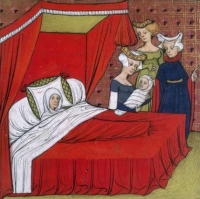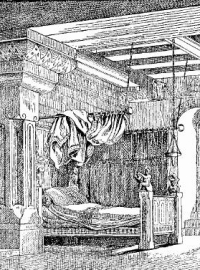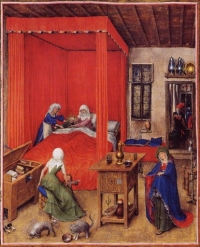-
History of:
- Resources about:
- More:
- Baby walkers
- Bakehouses
- Bed warmers
- Beer, ale mullers
- Besoms, broom-making
- Box, cabinet, and press beds
- Butter crocks, coolers
- Candle snuffers, tallow
- Clothes horses, airers
- Cooking on a peat fire
- Drying grounds
- Enamel cookware
- Fireplaces
- Irons for frills & ruffles
- Knitting sheaths, belts
- Laundry starch
- Log cabin beds
- Lye and chamber-lye
- Mangles
- Marseilles quilts
- Medieval beds
- Rag rugs
- Rushlights, dips & nips
- Straw mattresses
- Sugar cutters - nips & tongs
- Tablecloths
- Tinderboxes
- Washing bats and beetles
- Washing dollies
- List of all articles
Subscribe to RSS feed or get email updates.
When Lady Alice West left her son Thomas a bed in 1395, she specified the good quality bedding as well as the impressive hangings. She described a bed of tapestry-makers' work, with a set of red tapestries sprinkled with metal ornamentation and her ancestors' arms. She added the "stuff" belonging to it: that's to say "my best featherbed", and a blue canvas, and a mattress, and two blankets, and a pair of Rennes sheets, with a matching head sheet, Thomas' choice of six pillows, and a blue bedspread lined with miniver fur, and a coverlet of red sendal with an all-over pattern of chevrons.
Fifty earliest English wills in the Court of Probate, London: A. D. 1387-1439
In Warwick Castle in 1400 there was a bed of red damask embroidered with ostrich feathers, with a coverlet, tester and celure, three curtains of red tartarine, 18 matching tapestries, 6 red damask cushions and a transom of red sendal.
Patent Rolls of Henry IV
Warm and Snug: The History of the Bed
by Lawrence Wright, from Amazon.com
or Amazon UK
A Medieval Home Companion: Housekeeping in the Fourteenth Century by Tanya Bayard, from Amazon.comor from Amazon UK

In 16th century Scotland, as in England, the monarch's household travelled with many of their furnishings, including dinner services and beds. In 1539, moving James V's "great grene bed" about 20 miles from Falkland Palace to St. Andrews cost more than $100,000 in today's money, according to the National Trust for Scotland.
Beds in Late Medieval and Tudor Times
>> glossary of bed and bedding terms
 In
the 14th century the poorest people slept on a straw
mattress on the floor with whatever warm covering they could get. The richest
houses had large elaborate beds, with ornamented canopies, richly-embroidered hangings,
and soft featherbeds under the fine linen sheets. They were among the most splendid
pieces of furniture in a large house, and noblemen often had their emblems embroidered
on the hangings. They were a comfortable place to meet for a chat, or receive guests,
while displaying an abundance of fine textiles, as in
this scene from 1409. They could be social gathering places at night too,
as visitors of high status would be invited to sleep in a bed even if they had to
share.
In
the 14th century the poorest people slept on a straw
mattress on the floor with whatever warm covering they could get. The richest
houses had large elaborate beds, with ornamented canopies, richly-embroidered hangings,
and soft featherbeds under the fine linen sheets. They were among the most splendid
pieces of furniture in a large house, and noblemen often had their emblems embroidered
on the hangings. They were a comfortable place to meet for a chat, or receive guests,
while displaying an abundance of fine textiles, as in
this scene from 1409. They could be social gathering places at night too,
as visitors of high status would be invited to sleep in a bed even if they had to
share.
The picture (right) from 14th or 15th century France shows a canopied, curtained bed with a head sheet laid over the pillow resting on a sheet-draped bolster. Head sheets were gradually replaced by pillowcases and are not usually mentioned after 1500. A pillowcase was always called a pillow bere (bearer) until about the 16th century, but this could mean various kinds of pillow cover, not necessarily a linen pillowcase matching the sheets.
 Although
there were canopies and curtains, these weren’t the full four poster beds with poles
at each corner which started to arrive in the 15th century. In the late Middle Ages
the best beds had hangings draped from a frame which was suspended from the ceiling
beams (see left), sometimes supported by a tall bedhead too, and often with a canopy
called a tester or celure.
The actual bedstead was usually an independent structure within all the finery.
Beds tended to be quite high and might be raised further by being set on a platform.
High beds might have a servant's
trundle bed
underneath: for a personal valet or maid.
Although
there were canopies and curtains, these weren’t the full four poster beds with poles
at each corner which started to arrive in the 15th century. In the late Middle Ages
the best beds had hangings draped from a frame which was suspended from the ceiling
beams (see left), sometimes supported by a tall bedhead too, and often with a canopy
called a tester or celure.
The actual bedstead was usually an independent structure within all the finery.
Beds tended to be quite high and might be raised further by being set on a platform.
High beds might have a servant's
trundle bed
underneath: for a personal valet or maid.
Beds and bedding were so valuable and highly prized that they were not passed casually down the generations, and it is not unusual to find them mentioned in wills from the 14th century onward. A well-to-do but middling family might have one featherbed and feather bolster to pass on, while some of the wealthiest people could leave their descendants several beds with complete sets of expensive hangings and fine bedding. Even woollen mattresses were important enough to be passed on as a bequest in some families.
Simple beds in institutions like monasteries or almshouses might have a mattress, blanket, coverlet and plain pillow. In 1487 a generous benefactor who was leaving money to house old people added a pair of sheets to this list, and estimated that each bed would then cost 13 shillings and sixpence. By this time peasants were sleeping in a little more comfort, and were more likely to be raised off the floor. One mid-15th century inventory of a smallholder's possessions shows that he had "three boards for a bed", a sheet and pillows, as well as some worn coverlets and canvas covers.
 By the time Elizabeth I came to the throne, people still arranged beds in much the
same way. Except for the introduction of the four-poster in wealthy households and
a few inns, and the disappearance of the head sheet, the elements were familiar.
But more and more people acquired comfortable bedding and, overall, people's sleeping
habits changed. As the middle classes prospered, they too wanted featherbeds and
soft sheets. Around 1580 the clergyman William Harrison grumbled about the new generation,
so self-indulgent with their feathers and pillows. In his day "If in seven years
after marriage a man could buy a mattress and a sack of chaff to rest his head on,
he thought himself as well lodged as a lord. Pillows were thought meet only for
sick women. As for servants, they were lucky if they had a sheet over them, for
there was nothing under them to keep the straw from pricking their hardened hides."
By the time Elizabeth I came to the throne, people still arranged beds in much the
same way. Except for the introduction of the four-poster in wealthy households and
a few inns, and the disappearance of the head sheet, the elements were familiar.
But more and more people acquired comfortable bedding and, overall, people's sleeping
habits changed. As the middle classes prospered, they too wanted featherbeds and
soft sheets. Around 1580 the clergyman William Harrison grumbled about the new generation,
so self-indulgent with their feathers and pillows. In his day "If in seven years
after marriage a man could buy a mattress and a sack of chaff to rest his head on,
he thought himself as well lodged as a lord. Pillows were thought meet only for
sick women. As for servants, they were lucky if they had a sheet over them, for
there was nothing under them to keep the straw from pricking their hardened hides."
Making the bed
The best beds had a canvas mattress or two filled with wool or straw and then the featherbed. The under-mattress(es) might be laid on canvas spread over the bed slats, or possibly on woven rushes. The featherbed was an expensive luxury and was not plump enough to be used without an underlying woollen or straw mattress, perhaps with a canvas sheet separating rough from smooth. Even a flock or woollen mattress was out of reach for the poorest people, and wool-filled mattresses were valuable enough to be mentioned in "middle-class" wills.
Next a bolster was laid at the head end before a pair of sheets were put on. The best sheets were made of Rennes linen. Cheaper sheets were made of hemp or coarse linen. Blankets came next, and then a coverlet reflecting the wealth of the bed’s owner. The most luxurious could be lined with fur, or be reversible with two different expensive kinds of silk used in the making. If a head sheet was used it was laid over the pillow, probably shortly before bedtime so the decorative pillow-cover would be on display during the day.
You may also like pages about:
Featherbeds
Straw mattresses
Medieval tablecloths
Bed warmers

Ian Mortimer, The Time Traveler's Guide to Medieval England from Amazon.comor Amazon UK

Glossary ~ beds, bedding and fabrics
- Bedstead, bedstock – a frame with slats or boards or rope laid across under the mattress
- Joined bedstead - all-wooden bedstead
- Corded or rope bedstead - ropes supported the mattress instead of wooden slats
- Couch-bed - bed with no hangings
- Standing bed or stand bed - bed with hangings, high enough to have a truckle sliding beneath it
- Truckle bed or trundle bed - low movable bed hidden away during the day
- Trussing-bed - bed which can be taken apart, tied up, and transported
- Tester and Celure – both words can describe the canopy. Some people use tester to mean the rigid wooden frame or metal rods supporting the draped canopy and think of the fabric as celure. But the distinction is not clear-cut; one inventory in the 16th century refers to a "tester of damask". Tester comes from the French word for head, and celure has the same roots as the word ceiling.
- Hangings, curtains, ridels – hang from the canopy
- Costers – hangings for the lower sides of the bed, valance
- Dosser - hanging at the back of the bed
- Transom - fabric stretched across the head of the bed
- Pallet, palliasse, paillasse, chaff bed – straw-filled mattress (or chaff-filled)
- Mattress, flock-bed, woollen mattress, flock mattress – a mattress filled with bits and pieces of wool (flock) or possibly carded wool.
- Tick - cloth bag and mattress cover
- Featherbed – a “quilt” fabric bag (tick) filled with feathers. Often accompanied by a matching bolster.
- Bolster - a cylinder of stuffed fabric, filled with feathers or flock or wool. Stretched the whole width of the bed and was covered by the lower sheet.
- Pillows – could be very luxurious
- Pillow bere - pillow cover or pillowcase (pillow-bearer)
- Cod - northern English pillow or cushion (also Scotland)
- Sheets - made of fine linen, dowlas, canvas or hurden (see fabrics below).
- Head sheet – a piece of linen laid over a pillow
- Foot sheet – a cloth spread over the end of the bed to sit on while washing and dressing, also used as a sort of bath-mat to stand on.
- Blanket – woollen blanket
- Fustian - blanket made of coarse linen fustian
- Coverlet - a bedspread - could be very decorative, or plain woven wool.
- Happing - coverlet of lesser quality
- Coverture - coverlet, bedspread
- Quilt - either a feather or wool quilt used as a mattress, or a coverlet filled with wool
- Tartarine – "Chinese" silk from Tartary
- Sendal - thick silk
- Samite - rich silk , sometimes with gold threads woven through
- Damask - silk with woven designs
- Chamlet, camlet - a luxury fabric - the name often applies to a mixed weave of silk and animal hair or wool
- Sarsenet, sarcenet - fine, soft silk
- Arras - rich tapestry or hanging made of tapestry
- Say - fine serge, wool, or wool and silk
- Dornick - various blends and weaves in the style of Flemish Tournai (Doornik) fabric, used for hangings or covers
- Baudekin - brocade or other thick silk with designs on
- Vair - squirrel fur
- Miniver - white fur
- Rennes, Reynes linen – the finest linen sheeting as woven in Rennes in Brittany
- Carde – fabric used for hangings, probably linen
- Fustian - coarse linen cloth, (or cloth made from cotton and flax)
- Dowlas - coarse linen used for sheets
- Canvas - coarse cloth, could be used for sheets, or underneath mattress or featherbed
- Worsted - cloth made from wool spun with a firm twist
- Harden, hurden, hardine – rough hemp or linen cloth (made from hurds, oakum, tow)
- Flock – clumps of wool – later also scraps of cloth
Spellings may vary.
You may like our new sister site Home Things Past where you'll find articles about antiques, vintage kitchen stuff, crafts, and other things to do with home life in the past. There's space for comments and discussion too. Please do take a look and add your thoughts. (Comments don't appear instantly.)
For sources please refer to the books page, and/or the excerpts quoted on the pages of this website, and note that many links lead to museum sites. Feel free to ask if you're looking for a specific reference - feedback is always welcome anyway. Unfortunately, it's not possible to help you with queries about prices or valuation.





